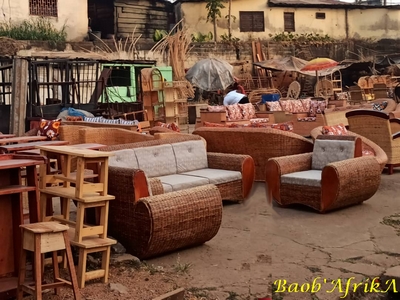Rattan processing
a job to earn a living

« This activity
allows many Cameroonians
to
earn their living with dignity »
There are three, four or even ten workers in workshops set up
in the open air not far from the Mvog-mbi crossroads in the district of
Yaoundé 4. These basket makers are more commonly called “rattan
workers”. Every morning, the artisans occupy their place of service
early. A working day which will last up to 18 hours depending on the
orders to be made.
The possibilities for using rattan are indeed very diverse:
construction of homes, furniture, baskets, baskets, fishing nets, etc.
Its transformation integrates all the techniques applied to raw,
treated or semi-treated rattan in order to convert it into finished
products..
These rattan workers are often fathers
of families. “We work according to the customer's order. There are
customers who ask us for somewhat complicated things.
As a specialist, you always have to look
for a way to satisfy them and this is not always easy. But most of the
time, we have orders for beds, tables, armchairs and others,” explains
Emmanuel Ndi, owner of a workshop and employer of two young teenagers.
“Traditionally,
basketry requires working tools
following:
knife, pencil, square, tape measure, hacksaw,
hammer, pincers, blowtorch and brushes, he adds.
Others
equipment makes work easier and of better quality,
such as stapler, hole punch, electric saw, steam chamber, air sprayer
and clamp. The craftsman must also have points, screws, glue, varnish,
thinner, gas, Xylamon and dye”
.

The transformation in question!
In its natural state, rattan is a plant
of the Palmaceae or Arecaceae family. It is a climbing vine with leaves
and thorny stems. It is after transformation that the stems or
branches, similar to those of palm trees, take the name rattan (the
best known name).
However, the transformation of this
plant generally growing in primary and secondary forests is done in
several stages as Emmanuel Ndi presents to us:
"It's
necessary
determine the model to make and select the appropriate stems, scrape
the small rattan using a kitchen knife to remove the cuticle and
take out the strips, if necessary, scrape the large rattan as well,
heat the stems in a steam chamber and bend them on the work table using
the templates.
Otherwise, use a blowtorch
to carry out the bending, mount the product in question using the
points, screws and staples, dip the strips of small rattan in
water for two to five minutes, then use them to attach the
seals. Ensure fasteners are well presented and cover all points as much
as possible, apply weaving and decoration techniques, then apply
chemical treatments for furniture only. This includes the application
of Xylamon to furniture, to protect it from attacks by insects and
larvae. Furthermore, other chemical treatments including dyeing the
rattan and applying varnish or oil paint also protect against fungal
attacks, burning the fibers and applying a preliminary coat of varnish.
Air dry or dry in the sun for 4 to 24 hours and revarnish.

All of this work leads to the assembly
of the framework, after which the furniture can alternatively be sanded
and stained using an electrostatic gun with polyurethane lacquers for
greater resistance to the sun, especially for furniture exposed on the
verandas where the sun's rays
can be important.
Then, a hard base is applied allowing
a new sanding, which permanently removes all rough edges.
Finally,
a matte or glossy polyurethane varnish is applied and the furniture is
then ready for sale.”
Constantin Yap
|
|
|


